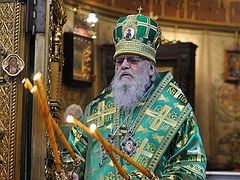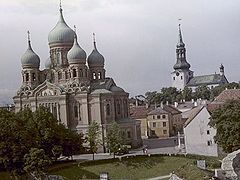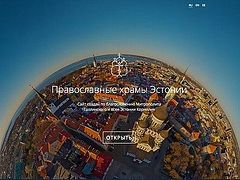His Eminence Metropolitan Cornelius of Tallinn and All Estonia, the primate of the Estonian Orthodox Church of the Moscow Patriarchate, reposed in the Lord on April 18, 2018, in his 94th year of life and his 72nd year of clerical ministry in the Church. His Holiness Patriarch Kirill of Moscow and All Russia extolled him as a man whose entire life was dedicated to serving God and man, refined by suffering at the hands of the Communist regime.
This interview was recorded in 2003 by brothers of Sretensky Monastery who had visited Metropolitan Cornelius at his Estonian residence at Pukhtitsa Monastery, asking the now-reposed archpastor about the USSR and the years of persecution, independent Estonia, the schism in Estonian Orthodoxy, and the daily lives of Estonians.
—Vladyka, what is Estonia in terms of religion? How many believers are there, and which confessions do they belong to?
—Estonia is, of course, a Protestant country, and the main confession is Lutheranism. Although, according to the Council of Churches, the Lutherans number 200,000, but there are 150,000 Orthodox of the Moscow Patriarchate, and this is perhaps a low figure. So they’re almost equal, and if we add the 20,000 from the Patriarchate of Constantinople, then they’re equal.
—How big is the population overall?
—1.5 million. Of course, that’s very small in comparison with Moscow. If we’re talking about our Church then we shouldn’t use the term “Russian Church,” because we officially exist as the Estonian Orthodox Church of the Moscow Patriarchate. Anyone can come to our Church: Estonians, Russians, Ukrainians, Belarusians—anyone. In the common language, at least among Estonians, many speak of us as the “Russian Church,” but this designation is purely according to its origin: When Orthodoxy began to emerge here in the early and mid-nineteenth century, it came from Russia.
—That is, Orthodoxy already has a great history here?
—It begins with Yaroslav the Wise, when he built the first city here, which of course had churches. There was always a church in Tallinn, of course. There were periods where it was closed and reopened. There were churches throughout the city before the German Order of Swordsmen entered, when they destroyed them all. The Monk-Martyr Cornelius of the Pskov Caves also preached here: He baptized people and built churches and parishes. And Narva was also an international city. There were Russians, Germans, and Swedes there; there were always Protestant and Orthodox churches coexisting there. There was a trade route to Pskov going through Estonia. So Orthodoxy has a great history here. Even in the chronicles, one Novgorod cleric asks questions of his bishop about it.
—You mean The Questions of Kirik?[1]
—Yes, and among these questions was, “How to baptize a Chudin?” (that is, an Estonian), and the bishop answers. Probably some Estonians wound up in Pskov and in Novgorod, but there was no mass acceptance of Orthodoxy—Estonians mainly remained pagans. Initially they were forcibly baptized by Catholics into their faith. Then, when local German barons adopted Lutheranism, they also forced Estonians to convert to Lutheranism. No one asked them, they had nothing, no rights. The Germans occupied and exploited them…
—Vladyka, from what you have said, I understood that the Estonian Orthodox Church today is neither a national Church of Estonians nor a Church of the Russian diaspora. Is that correct?
—It’s not a Church of the Russian diaspora in any case. But I don’t know what to consider the Russian diaspora, what you mean by this word. My great-great-grandfather moved here from the Rostov Province in the beginning of the nineteenth century with his wife, his sister, and his brother, and settled in Revel,[2] and took up horticulture—can this be called a diaspora?
—No, that would rather be native Estonians…
—There were many such people here: the Malakhovs, the Demins. They were native Revel merchants—local residents. We had our own Orthodox churches. But Estonian national Orthodoxy emerged in the beginning of the twentieth century. We can find historical information about this in His Holiness Patriarch Alexei’s work, Orthodoxy in Estonia, although in his work he moreso notes the external side of the origin of Estonian Orthodoxy. I’m personally interested in the internal reasons. Why did Estonians become Orthodox?
—And what are these reasons?
—There are various reasons. I once noted in my report on the history of Pukhtitsa Monastery that the population here was mixed, and there were Lutheranized Russians, but in some ways they preserved Orthodox traditions: They fasted, and so on. And before there was a monastery here, somewhere in the middle of the nineteenth century, many local Estonians would always gather here on the Dormition of the Mother of God. And many Estonians come to Pukhtitsa Monastery now, and Estonian speech is heard. We can’t consider the monastery some kind of piece of Russia in Estonia. The Mother of God appeared here before there was any kind of national definitions. It was a sign for the whole Estonian land!
—When was the appearance of the Mother of God?
—According to tradition, it was in the sixteenth century. The Mother of God appeared to Estonian Christians—Lutherans. They saw her and they found an icon which they gave to Russian Christians from the village of Yama. That means they coexisted here and respectfully related to sacred Orthodox objects: They passed on the icon rather than throwing it away, knowing that it’s necessary for Russians. And where are the descendants of those whom the Mother of God appeared to? I don’t know how to resolve these issues. But it is our common Estonian holy icon. The blessing of the Mother of God is upon the Estonian land.
—Have there been many saints in Estonia?
—It’s been different at different times. In the sixteenth century there were Hieromartyr Isidore and his parishioners who were drowned by Germans. We consider the Monk-Martyr Cornelius ours, and St. Alexander Nevsky. Hieromartyr Arseny (Matsievich) was confined in Revel, and he departed to the Lord there. Later, there was Bishop Platon (Kulbush) and the priests shot with him. Hieromartyr Metropolitan Agafangel (Preobrazhensky) ruled the diocese. There’s a canonized priest who was shot in 1918. His grave has been preserved, and we’re going to open his grave and uncover his relics.[3] Archpriest Karp (Elb), an Estonian, was a priest in St. Petersburg who was shot in 1937. So we also have our own saints[4]… I have the dream of canonizing three people—representatives of the Russian Christian student movement—people who dedicated their lives to Christian preaching among the youth—missionaries. In the first days when the Soviet authorities came here, they arrested the three of them. Their case was published in the journal “Russian Christian Student Movement Gazette.” They explicitly stated that their purpose was to combat atheism and communism and to educate the people. So they were people of good lives. The three of them were immediately shot… Church life here was more traditional in pre-war times. The Twelve Great Feasts were celebrated, people were baptized, married. But the spiritual level began to rise thanks to this student movement. And, oddly enough, the religious level began to rise significantly when the Soviet authorities and people arrived here.
—Why?
—Because the Church was persecuted—what kind of believers would there be in it? Only those who were believers by conviction! There were more services. People sought out the Church.
—Vladyka, we know that you also had a difficult path in life, that you suffered a lot from the communist regime…
 Metropolitan Cornelius of Tallinn and All Estonia during his final Holy Week (2018). Photo: orthodox.ee
Metropolitan Cornelius of Tallinn and All Estonia during his final Holy Week (2018). Photo: orthodox.ee —That might be a bit of an exaggeration. Although I spent three and a half years in prison, it was the Khrushchev times. It wasn’t Solovki; it wasn’t Kolyma. We worked, of course, but it was warm; we received packages, so we didn’t’ sit there hungry. Of course, there were internal struggles: separation from family, from loved ones, having to live without the Church; any religious manifestation, of course, was persecuted. It happened that the Gospels were taken away… In this respect it was hard.
—Why were you imprisoned?
—For storing and distributing “anti-Soviet literature,” as they called anything Orthodox, religious, or philosophical; and for anti-Soviet propaganda, that is, statements in an anti-Soviet spirit. All the charges were later dropped because they were made up. The Khrushchev persecutions had just begun then, and they had to seize people in the major cities and make an exaggerated case: Look at what these priests are doing!
—Were you able to participate in the Russian student movement?
—I wasn’t able to. But my late matushka (she was older than me) participated. She was a very active member of this Christian movement, and she had very good relations with its leaders…
—His Holiness Patriarch Alexei’s parents also took an active role in it…
—The patriarch’s father was even the chairman of the movement for a while. He took an active part. He wasn’t a priest yet then.
—Vladyka, could you tell you us what your path was like before you became the primate of the Estonian Orthodox Church?
—I didn’t have any special path. I was a parish priest in Tallinn, nothing more. Really, for almost thirty years. This year marks fifty-five years since I became a priest. And before that I was a deacon…
—You were probably already acquainted with the future Patriarch Alexei II then?
—I have known the patriarch from my youth. We lived in the same city, we would meet somewhere and talk…
—Vladyka, what languages are the services celebrated in now in the Estonian Church?
—In our jurisdiction, mainly only in Slavonic. In our cathedral we have a Liturgy in Estonian once a week, and in the other services we read individual exclamations in Estonian, but, in general, the parishes are divided on a national basis.
—Do you mean the division with the Constantinople jurisdiction?
—Yes. It was purely a governmental provocation, because at the beginning of the rebirth of the Estonian Republic, they came out everywhere very actively against everything Russian, against Russia. How the schism happened is all written in the books. Estonians are, generally speaking, not very religious by nature. When there was an Orthodox tsar, they hoped he would support them, but when the independent Estonian Republic emerged in the twentieth century, such times disappeared and anti-Russian trends appeared.
—How did the relationship with the authorities change after the arrival of the new president Arnold Rüütel?[4]
—The president doesn’t have great rights here—the Council of Ministers decides everything. The president is an Orthodox and benevolent person. But his predecessor was hostile, so the story with our Church was his initiative. It was his handiwork.
—But now there is a positive trend?
—The thing is that the Constantinople jurisdiction has been affirmed here and is officially recognized as the legal successor of the Church that was here before the war, before 1940, and all property rights are recognized for it. We received jurisdictional rights just a year ago, but the situation with property rights for the Estonian Orthodox Church of the Moscow Patriarchate remains difficult.
—Is there any problem of a lack of priests in the Estonian Church?
—Yes, although it’s become a little better now. Two-thirds of our priests have been ordained during my time. It would be good if we had three or four more priests.
—Are there any seminaries in Estonia?
—No, we don’t have any means for that; there is no pedagogical standard. It’s easier to study in Russia where it’s on a higher level.
—What is the situation with monasticism in the Estonian Orthodox Church?
—Pukhtitsa Monastery, Pskov Caves Monastery. There are several Estonians in Pechory,[5] and in Pukhtitsa too. Estonians obviously don’t really have a monastic spirit. They have more of a Protestant spirit and attitude. But Hieromonk Samuel serves here in Pukhtitsa Monastery—he’s an Estonian, and another priest is also an Estonian.
—Vladyka, how do you see the future of the Estonian Orthodox Church? What will it be: an exarchate, or an autonomous or autocephalous Local Church?
—The thing is that when Estonia was formed as an independent state, the Estonian government declared that an independent state should have an independent Church. But I have thirty parishes—what kind of autocephaly is that? There’s one monastery—Pukhtitsa, and no men’s monasteries. Publishing? Well, something has been published about Estonian priests, about the saints of the Estonian land, and some other things. Of course, everyone in Estonia understands that if we’re going to talk about Orthodoxy we have to talk about the Orthodox Church of the Moscow Patriarchate. Not long ago, while on a Baltic Sea cruise, Patriarch Bartholomew of Constantinople came to Tallinn and was present at two Estonian churches for services. It was strange that he was present but didn’t participate. But both times, at the Vigil and at the Liturgy, there were (taking into account his whole retinue, journalists, and so on) only a hundred people—for the Ecumenical Patriarch!
—You didn’t meet with him?
—No. When he came here the first time, they sent me an invitation, but I didn’t go. Patriarch Bartholomew served Liturgy in the Estonian Transfiguration Cathedral then.
—Can this split be healed?
—I don’t know how to go about healing it… The national factor plays a very big role here. Estonia is an independent state, and the nationalists had the hope that everyone would gradually move over to the Constantinople jurisdiction. But there has been no such trend! And if they wanted to come over to us now, we’d have to think twenty times about whether or not to accept them. They’ve already gone too far: They commune without confession, and so on.
—That means unification is already impossible?
—I cannot say it’s impossible. It’s possible! Maybe the next hierarch who will come after me will be able to carry it out…
Metropolitan Cornelius of Tallinn and All Estonia was interviewed by monks of Sretensky Monastery in June 2003 at Pukhtitsa Convent.









